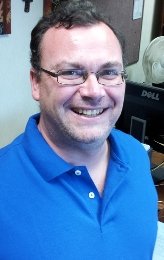Thomas Maccarone

What are your current research interests?
I am interested in binary star systems where one of the members is a black hole or neutron star and the other object is a more normal star that is transferring some of its mass into the black hole or onto the neutron star. I try to understand both how gas flows into these objects, and how binary evolution processes and stellar dynamical interactions in star clusters produces them.
I've also spent a fair fraction of my science time in the past 5 years on working on proposals for new astronomical facilities. In particular, I was the main coordinator of the science case development for a mission called STROBE-X, which, if it flies, would be the largest X-ray telescope ever built, and I have been serving on the Scientific Organizing Committee for the Next Generation Very Large Array project, which aims to replace the current Very Large Array in New Mexico with a Continent-scale facility that would have about 10 times as much collecting area. For that project, I have mainly been coordinating the development of the case for the placement of the most distant antennas in the array, that would provide the sharpest imaging.
What types of outreach and engagement have you been involved with?
I have done several things. I have been one of the faculty members helping to organize Texas Tech's Astronight events, where we combine a public talk, a bunch of science demonstrations, and, weather-permitting, observing. This has involved a lot of student volunteer efforts as well. I've also given public talks at the Alamo Draft House a few times, to the South Plains Astronomy Club and to various groups of local K-12 students. More recently, making lemons from the lemonade of the global pandemic, with many of these types of activity going online, I have spoken to the Saudi Youth Space club, and have a talk lined up soon with the Astronomical Society of the Dominican Republic.
Why did you choose this field?
I gradually drifted into astronomy. I had been interested in some kind of scientific career since elementary school. I settled on majoring in physics in my freshman year of college. Then, I took a few astronomy classes, and I think what drew me into the field was mostly that we were talking about real big picture questions in sophomore/junior level classes, while in the classes in the physics departments, we were focused on a very mechanical approach to learning procedures for solving problems that was often not very well connected to the exciting problems that can be solved in other areas of physics.
How do you define good teaching?
To be a bit flippant at first, teaching that gets the students to learn something and inspires them to want to learn more. But to be a little more specific, as I alluded to above, I think one of the keys of improving teaching in physics is to make sure that the skills students learn are placed into a context of where they will be applied. This often falls by the wayside in any traditional approach to the subject, and I often find that in astronomy classes, I end up reinforcing physics knowledge. I think good teaching requires interaction with the students and flexibility. It's important to figure out what students already know and don't know and want to know and make some small adjustments to the lesson planning based on that.
What is your proudest professional accomplishment?
I was one of the founding members of the astrophysics research group we have here at Texas Tech. I am very proud of how all of us here have grown the program into one of the strongest small astrophysics groups in the United States.
How do you integrate research and outreach into teaching?
Integrating research into teaching is straightforward. I try to make sure that students understand how the concepts they are learning show up in real situations in the research environment. Sometimes that involves a digression from the topic we are discussing. Rather than integrating outreach into teaching, though, I think it's better to integrate teaching into outreach. In a lot of our outreach programs in physics and astronomy, including a lot of the ones I have worked with, we bring students into the project, having them do a sizeable chunk of the presentations. We can these use these activities as a way to make sure that the students really understand what it is that they're trying to explain to the general public, and they inevitably deepen their understanding of the things they already understand pretty well by communicating it.
More About Thomas Maccarone
I spent my early childhood in the very small town of Rowley, Massachusetts, along the coastline, near the New Hampshire border. At age 9, my family moved to the the town of Swampscott, a suburb of Boston. I then did a bachelor 's degree in physics at the California Institute of Technology, and followed that with graduate degrees in astronomy at Yale University. I spent the next 11 years in Europe, as a postdoctoral fellow at the International School for Advanced Studies in Trieste, Italy, and the University of Amsterdam, and then as a lecturer then reader at the University of Southampton. A little less than 8 years ago, I moved to Lubbock to help start up the astrophysics program at Texas Tech.
Office of the Provost
-
Address
104 Administration Building, Box 42019, Lubbock, Texas 79409-2019 -
Phone
806.742.2184 -
Email
provost.communications@ttu.edu
